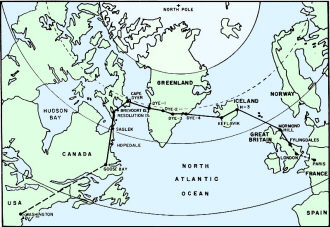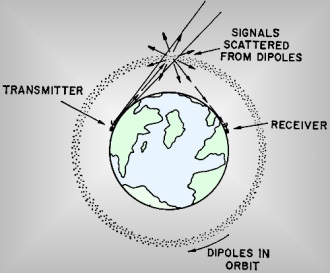|
March 1969 Radio-Electronics
 [Table of Contents] [Table of Contents]
Wax nostalgic about and learn from the history of early electronics.
See articles from Radio-Electronics,
published 1930-1988. All copyrights hereby acknowledged.
|
"News Briefs" in the March
1960 issue of Radio-Electronics magazine contained many very interesting developments
related to research and development in communications. Headlines included among
other things Tropospheric Telephone Spans Atlantic, TV, Radio Astronomy Struggle
for Channel 37, Needle Belt Orbits, Laser Transmits 118 Miles, Diplomat's Dog Is
Howling Counterspy, and, Short-Wave Listeners Hear Ham Gossip, Space News. A decade
has passed since the International Geophysical Year (IGY) results had come in and
much work in tropospheric and ionospheric signal scatter, absorption, and reflection was in process.
An intense battle between the Communist world and the free world for technology
dominance was a major factor in the process. The Space Race was in full gear, with
Apollo 11 scheduled to land the first men on the moon within a few months.
Reliable communications between Earth and the lunar lander and command module was
essential, so characterization of atmospheric phenomena was critical.
New Briefs:
11/1957
| 8/1958 |
11/1959 |
2/1960 |
4/1960 |
8/1960 |
3/1961 |
5/1961 |
6/1961 |
12/1961 |
3/1963 |
4/1963 |
8/1963 |
9/1963 |
8/1964 |
12/1964 |
1/1967 |
3/1967 |
4/1967 |
9/1967 |
4/1968
News Briefs
 Tropospheric Telephone Spans Atlantic Tropospheric Telephone Spans Atlantic
The first public demonstration of trans-Atlantic voice communication by multichannel
tropospheric-scatter radio took place as part of the opening ceremonies of the 17th
Annual Armed Forces Communications & Electronics Association (AFCEA) Convention.
Conversations between Brig. Gen. J. Francis Taylor, Jr., vice president of AFCEA
in Washington; Lieut. Col. J. C. Posey in London, president of the AFCEA London
Chapter; AFCEA national president Frank A. Gunther, president of Radio Engineering
Laboratories, Inc., who built the equipment, and others, marked the event.
The route of the trans-Atlantic AFCEA trap a phone call.
Tropospheric scatter has long been considered a possibility for wide-band intercontinental
communication ("Worldwide Television," Radio-Electronics, September 1956, page 37)
and has been informally used by the United States Air Force since the middle of
1962.
The route taken by the trans-Atlantic tropo signals is shown in the illustration.
From Washington to Goose Bay, transmission was by conventional telephone lines.
From there to London, transmission was in a series of 13 tropospheric hops.
TV, Radio Astronomy Struggle for Channel 37
"Scientific research could be seriously damaged," American Geophysical Union
warns, if Channel 37 should be made available to commercial television. The reason
for the statement is that an application has been made for a New Jersey TV station
on that frequency.
Channel 37 is in the part of the spectrum used by the University of Illinois
radio telescope (Radio-Electronics, May 1963, p. 10).
This region is the only one in which certain radiation rings of Saturn, the frequencies
from the sun and the radiation belts around Jupiter can be studied.
The FCC proposed to exclude commercial stations from Channel 37 within 600 miles
of the University of Illinois station for 5 years. International scientists, however,
feel that television use of the channel would represent a serious waste of a precious
national resource, in view of the fact that a number of phenomena can be studied
only in the 608-614-mc band. According to the National Academy of Sciences, US scientific
effort in radio-astronomy could suffer seriously if the channel were devoted to
entertainment.
 Needle Belt Orbits Needle Belt Orbits
Successful experimental transmissions by reflection from the West Ford Dipole
Belt have been reported by the Air Force. The belt consists of more than 400 million
hair-like metallic fibers, less than 1 inch long, scattered in a thin, narrow orbital
ring about 2,000 miles above the earth in a near-polar orbit. It is expected that
the dipoles may make a very effective and reliable communication circuit, since
they would act as an artificial ionosphere, returning signals at the dipoles' resonant
frequency, much more efficiently than could a small passive satellite.
According to the Massachusetts Institute of Technology's Lincoln Laboratory,
which conducted the experiment for the Air Force, pressure of sunlight is expected
to force the fibers down to lower altitudes in a few years, and they will be destroyed
as they enter the atmosphere.
How the signals would be reflected tram the West Ford Dipole Belt.
There was considerable objection to the West Ford Project from international
astronomers, and even The New York Times, in a leading editorial, protested the
"unilateral decision" which put the dipoles into space "without adequate international
consultation."
Laser Transmits 118 Miles
The record for laser transmission is claimed by Electro-Optical Systems of Pasadena,
Calif. Using a helium-neon gas laser with confocal mirrors, a voice signal was transmitted
from a point in the San Gabriel Mountains to a receiver located 12 1/2 miles from
the town of Ballart, Calif., near Death Valley. The distance was 118 miles. The
transmitter wavelength was 6,328 Angstroms, and the radiated power 125 microwatts.
The message was about 300 words long. The receiver used a 12 1/2-inch-diameter telescope
as an antenna, and detected the message with an S-20 photomultiplier tube.
Diplomat's Dog Is Howling Counterspy
The State Department's most experienced electronic security specialist, inspecting
the home of an overseas U. S. attache, was distracted recently by the whining of
the attache's dog. The pet was "obviously in pain and appeared to be in heated combat
with an invisible enemy in a corner of the room."
The security specialist lifted one of the floor slabs in the corner and found
an FM radio, which was "transmitting to a distant eavesdropper all the conversations
held in the room." The device was turned on and off by a sound signal too high-pitched
for detection by the human ear, but annoying and painful to a dog.
The State Department, declining to state where the bugging occurred, calls the
incident "The Case of the Howling Dog."
Short-Wave Listeners Hear Ham Gossip, Space News
The Voice of America is broadcasting amateur radio programs to all areas of the
world at various times throughout the day. The 15-minute programs consist of ham-band
gossip, interviews, propagation forecasts, technical news. Broadcasts, in English,
are written and voiced by Bill Leonard, W2SKE. Another broadcast service, "spacewarn,"
co-sponsored by the National Academy of Sciences, is heard on short wave 6 days
a week (Tuesday through Sunday) from 0330 to 0335 GMT. It offers orbit data and
radio frequencies on new satellite launchings, plus late statistics on satellites
in orbit.
Posted June 22, 2023
|











